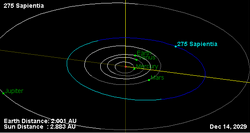Astronomy:275 Sapientia
 Orbital diagram | |
| Discovery | |
|---|---|
| Discovered by | Johann Palisa |
| Discovery date | 15 April 1888 |
| Designations | |
| (275) Sapientia | |
| Pronunciation | /seɪpiˈɛnʃə/ |
| Named after | Sapientia |
| A888 GB, 1906 AB 1962 GE, 1962 HA | |
| Minor planet category | Main belt |
| Orbital characteristics[1] | |
| Epoch 31 July 2016 (JD 2457600.5) | |
| Uncertainty parameter 0 | |
| Observation arc | 124.23 yr (45374 d) |
| |{{{apsis}}}|helion}} | 3.22294 astronomical unit|AU (482.145 Gm) |
| |{{{apsis}}}|helion}} | 2.31754 AU (346.699 Gm) |
| 2.77024 AU (414.422 Gm) | |
| Eccentricity | 0.16342 |
| Orbital period | 4.61 yr (1684.1 d) |
| Mean anomaly | 300.952° |
| Mean motion | 0° 12m 49.54s / day |
| Inclination | 4.76416° |
| Longitude of ascending node | 134.097° |
| 40.0578° | |
| Physical characteristics | |
| Dimensions | 103 km |
| Rotation period | 14.931 h (0.6221 d) |
| Geometric albedo | 0.036 |
| C | |
| Absolute magnitude (H) | 8.85 |
Sapientia (minor planet designation: 275 Sapientia) is a very large Main belt asteroid that was discovered by Johann Palisa on 15 April 1888 in Vienna. It is classified as a C-type asteroid and is probably composed of carbonaceous material. It is named for the Roman personification of wisdom, Sapientia.[2]
Observations performed at the Palmer Divide Observatory in Colorado Springs, Colorado, during 2007 produced a light curve with an estimated period of 14.766±0.006 hours with a brightness range of 0.11±0.02 in magnitude.[3] A 2014 study found a period of 14.931±0.001 hours with a variation of 0.12±0.01 in magnitude. The light curve was found to be irregular, suggesting the asteroid has an irregular shape.[4] On September 30, 2015, the asteroid was observed occulting the 7th magnitude star HIP 14977 from multiple sites in Europe. The resulting chords showed a nearly circular prolate spheroid profile.[5]
References
- ↑ "275 Sapientia". JPL Small-Body Database. NASA/Jet Propulsion Laboratory. https://ssd.jpl.nasa.gov/sbdb.cgi?sstr=275;cad=1.
- ↑ Schmadel, Lutz D. (11 November 2013). Dictionary of Minor Planet Names. Springer Science & Business Media. ISBN 9783662066157. https://books.google.com/books?id=eHv1CAAAQBAJ&q=sapientia&pg=PA57.
- ↑ Warner, Brian D. (September 2007), "Asteroid Lightcurve Analysis at the Palmer Divide Observatory", The Minor Planet Bulletin, Bibcode: 2007MPBu...34...72W.
- ↑ Pilcher, Frederick (January 2015), "Rotation Period Determinations for 275 Sapientia, 309 Fraternitas, and 924 Toni", Bulletin of the Minor Planets Section of the Association of Lunar and Planetary Observers 42 (1): pp. 38–39, Bibcode: 2015MPBu...42...38P.
- ↑ Miles, R.; Haymes, T. (December 2015), "Asteroids and Remote Planets Section: Stellar occultation by asteroid (275) Sapientia well seen from the UK", Journal of the British Astronomical Association 125 (6): 331–332, Bibcode: 2015JBAA..125..331M.
External links
- Lightcurve plot of 275 Sapientia, Palmer Divide Observatory, B. D. Warner (2007)
- Asteroid Lightcurve Database (LCDB), query form (info )
- Dictionary of Minor Planet Names, Google books
- Asteroids and comets rotation curves, CdR – Observatoire de Genève, Raoul Behrend
- Discovery Circumstances: Numbered Minor Planets (1)-(5000) – Minor Planet Center
- 275 Sapientia at AstDyS-2, Asteroids—Dynamic Site
- 275 Sapientia at the JPL Small-Body Database
 |

